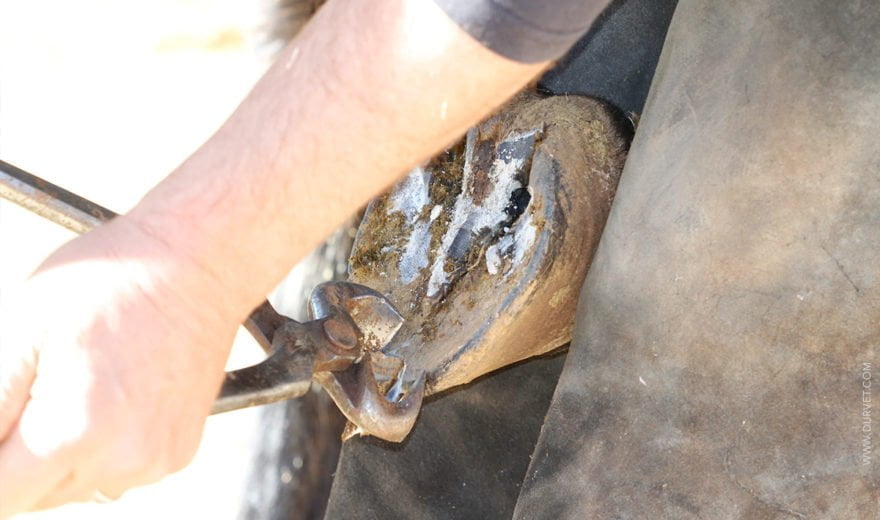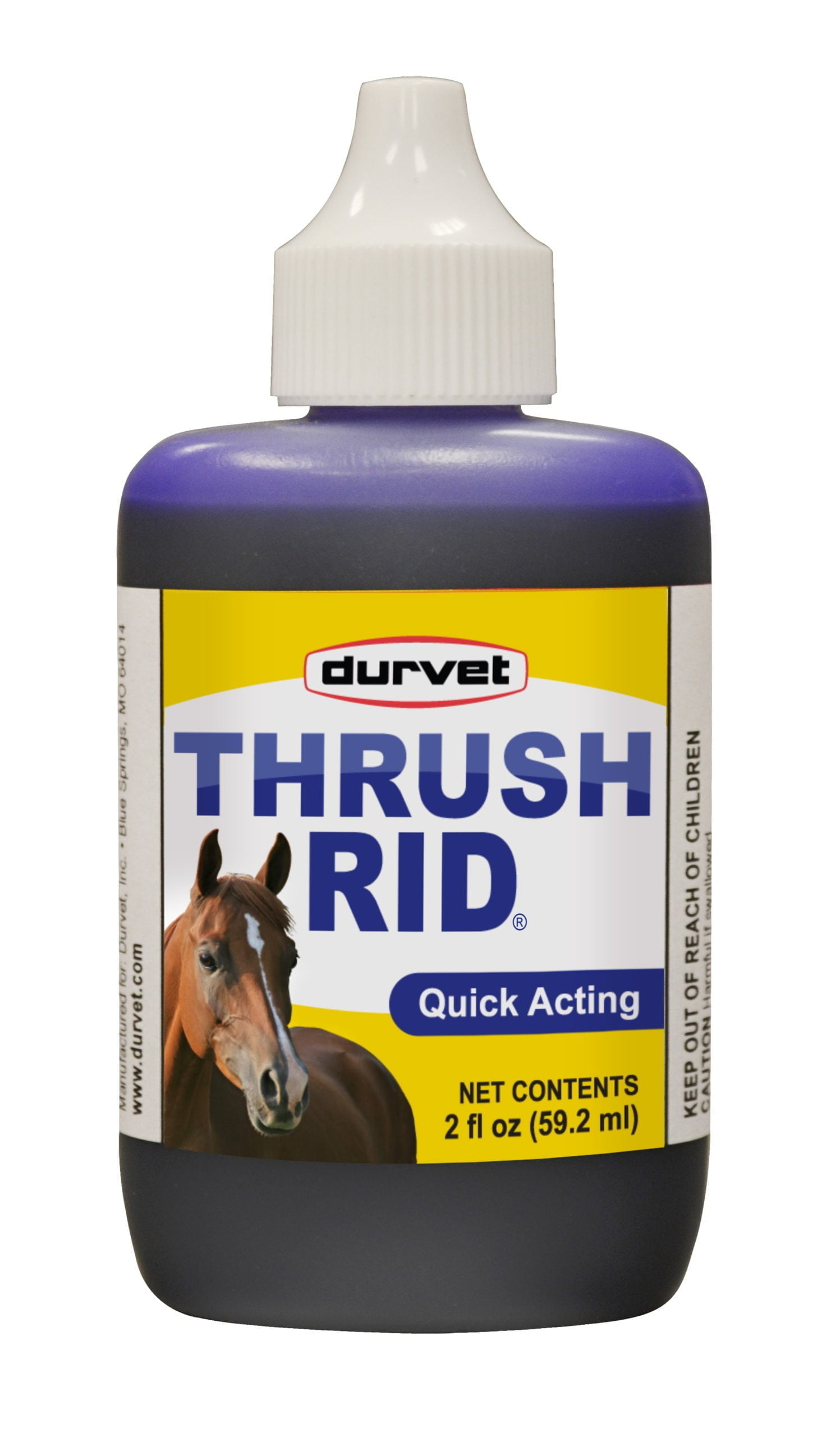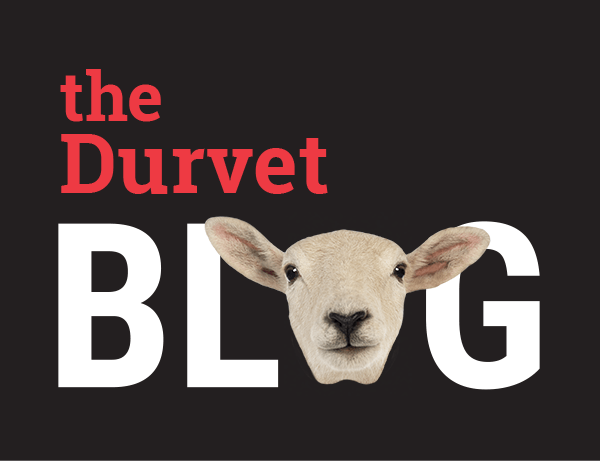
Maintaining your horse's hooves should be a routine part of their health care. No matter the activity level and lifestyle, many different hoof problems can arise in horses. For maximum horse health and longevity, regular hoof care is a must to ensure hoof and leg soundness. A good working relationship with a farrier and veterinarian is essential to prevent and solve hoof problems.
Trimming
First Trim
Foals should be trimmed for the first time at one to two weeks of age. Correcting hoof structure early is important. Not all foals are born with perfect hoof and leg structure, so hoof care should start at an early age to maintain soundness. Corrective trimming can help correct and minimize leg and hoof deviations if done within the first year of age.
Summer
In the summer, horse's hooves should be trimmed at least every six to eight weeks. Other horses, especially more active and show horses require more frequent trimming.
Winter
Since horse's hooves grow slower during the winter, you can trim less frequently. Based on your horses hoof growth, you should trim or shoe hooves every 6 to 12 weeks. Horse owners must realize that the following factors could effect the frequency of trimming:
- Age of horses: Younger horses tend to grow hoof faster than old horses.
- Weather Conditions: Hooves grow slower during cold winter months.
- Nutrition: Horses inadequate in nutrition will grow less hoof than horses receiving adequate to excess nutrition.
- Environment: Horses kept in soft pastures will appear to grow more hoof than horses kept in rocky/harder terrain due to less natural wear.
- Exercise: Well fed and exercised horses are more likely to have healthier hooves than those that are kept in a stall with little to no exercise.
Although 10-12 weeks is a good rule of thumb for frequency of hoof trimming for non-use or light use, owners should manage each horse's hoof care based on it's activity and individual needs.
Hoof Balance
Balance, balance and more balance are the primary concerns when trimming or shoeing a horse. A balanced hoof allows the horse to move better and puts less stress and strain on bones, tendons and ligaments. A balanced hoof and lower leg will have equal medial/lateral size and shape, along with anterior/posterior balance. When trimming a hoof, keep the following in mind:
- Straight Hoof-Pastern Angle: There is a straight line from the pastern down through the hoof. This allows the leg and hoof bones to be aligned properly from pastern to coffin bone.
- Easy Break-Over: The toe is not too long or too short and is squared, rounded or rolled. This allows easier movement with each step.
- Adequate Heel Support: The shoe extends back to the end of the hoof wall and supports the back of the entire leg.
- Medial-Lateral Balance: The foot lands evenly from side to side as the horse walks.
Nutrition
Maintaining a horse's nutrition can help alleviate and prevent some hoof problems. Feeding good quality hay, supplementing the appropriate vitamins and minerals and making sure the horse has constant access to fresh, clean water is important for hoof health and overall horse health. Research has shown poor quality hooves can greatly benefit from available hoof care products that contain:
- Biotin
- Iodine
- Methionine
- Zinc
Common Hoof Problems
Poor shoeing or trimming. Long, untrimmed hooves can result in collapsed heels, strain on flexor tendons and the navicular bone. If the hoof is trimmed too short, it can cause trauma to the joint and coffin bone. An imbalanced hoof can cause stress on the collateral ligaments and joints.
Hoof cracks. Cracked hooves can be caused by overgrowth, dryness, poor nutrition and several other factors. They can be painful and uncomfortable for your horse. During dry weather, you can apply hoof moisturizer to the hoof wall and sole. To help prevent cracked hooves, be sure to maintain a regular trimming schedule during dry weather, provide good nutrition and provide hoof supplements to improve quality.
Thrush. Thrush is a foul-smelling, black oozing liquid, usually found around the frog of the foot, that is associated with wet, soiled conditions. Thrush can be uncomfortable, invade sensitive tissue and cause lameness. Keeping barns and stalls clean and dry will help to prevent thrush.
Solar Abscess. Horses with sudden or severe lameness is likely due to a solar abscess. A solar abscess is an infection in the sole of the hoof caused by trauma, bruising or a foreign body. You can help treat a solar abscess by removing the foreign body, soaking in warm water and Epsom salt and keeping the hoof bandaged, clean and dry.
Hot Nail or Street Nail. A hot nail is a horseshoe nail within a sensitive area of the horse's hoof. A street nail is any foreign object that enters the horse's foot. These conditions will most likely cause lameness and are treated with a removing the object, tetanus shot, cleaning with antiseptic and packing the hole/bandaging the foot.
Laminitis. Laminitis is inflammation of the sensitive laminae. Also referred to as founder, laminitis is the rotation or sinking of the coffin bone. Treatment includes regular trimming, proper balance and shoeing, maintaining short toes, and frog and sole support.
Navicular. Navicular syndrome includes disease process involving the navicular bone, bursa, ligamentous and soft tissue structures. Horses will usually land on their toe first due to heel pain. Navicular syndrome can be caused by genetics, faulty conformation, hoof imbalance and exercise on hard surfaces. Treatments include shoeing, trimming, elevating the heels and rest.
Conclusion
- Schedule regular trimming and shoeing every 6-12 weeks (based on your horse's activity level).
- Maintain a relationship with a farrier who provides good hoof balance.
- Provide appropriate shoeing for different weather and footing conditions.
- Provide appropriate treatment and medication when disease occurs.
- Maintain proper horse nutrition.
Please Note: This information is for educational purposes only and not intended to treat, diagnose or prevent any disease. In all cases, it is each owner's responsibility to obtain veterinary services and advice before using any of the information provided. Durvet encourages owners to make their own animal health care decisions in partnership with their veterinarian. Please read all labels carefully. Product is for veterinary use only. Not intended for use in humans.
Sources:
University of Minnesota Extension, Horse Extension, Utah State University Cooperative Extension

 BACK TO MAIN BLOG
BACK TO MAIN BLOG 

Comment